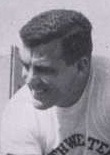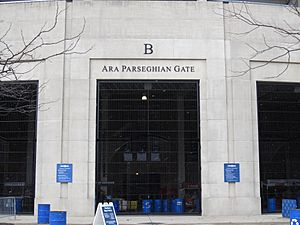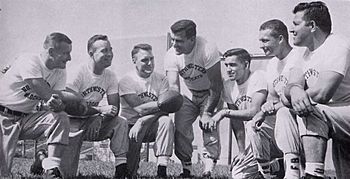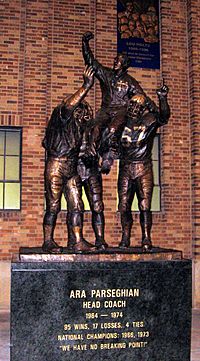Ara Parseghian facts for kids
Quick facts for kids
Ara Parseghian
|
|
|---|---|

Parseghian with Northwestern in 1956
|
|
| Born | May 21, 1923 Akron, Ohio, U.S.
|
| Died | August 2, 2017 (aged 94) Granger, Indiana, U.S.
|
| Resting place | Cedar Grove Cemetery, Notre Dame, Indiana |
| Coaching career | |
| Playing career | |
| 1946–1947 | Miami (OH) |
| 1948–1949 | Cleveland Browns |
| Position(s) | Halfback, defensive back |
| Coaching career (HC unless noted) | |
| 1950 | Miami (OH) (assistant) |
| 1951–1955 | Miami (OH) |
| 1956–1963 | Northwestern |
| 1964–1974 | Notre Dame |
| Head coaching record | |
| Overall | 170–58–6 |
| Bowls | 3–2 |
| Accomplishments and honors | |
| Championships | |
|
|
| Awards | |
|
|
| College Football Hall of Fame Inducted in 1980 (profile) |
|
Ara Raoul Parseghian (May 21, 1923 – August 2, 2017) was a famous American football player and coach. He is best known for leading the University of Notre Dame to two national championships in 1966 and 1973. Many people consider him one of the greatest coaches in Notre Dame's history.
Parseghian grew up in Akron, Ohio. He started playing football in high school. After high school, he joined the U.S. Navy during World War II. When the war ended, he finished college at Miami University in Ohio. He then played as a halfback for the Cleveland Browns in 1948 and 1949. The Browns won the league championship both years.
A hip injury ended Parseghian's playing career early. He became an assistant coach at Miami of Ohio. In 1951, he became the head coach. He coached there until 1956. Then, he became the head coach at Northwestern University. He helped turn their team into a strong competitor.
In 1964, Parseghian became the coach at Notre Dame. The team had not been doing well for several years. He quickly made them a top team again. He won two national titles in 11 seasons. This time is often called "the Era of Ara." His teams were almost always ranked among the best in the country. He never had a losing season at Notre Dame.
After retiring from coaching in 1974, Parseghian became a sports broadcaster. He also worked to raise money for medical research. This was because his daughter had multiple sclerosis. Also, three of his grandchildren died from a rare genetic disease. Parseghian was inducted into the College Football Hall of Fame in 1980.
Contents
Early Life and High School Football
Ara Parseghian was the youngest of three children. His father was Armenian, and his mother was French. They lived in Akron, Ohio. His father came to the U.S. in 1915. He was escaping the Armenian genocide during World War I.
Ara was very active and tough from a young age. He played basketball at the local YMCA. His mother did not want him to play contact sports. So, he did not play organized football until his junior year at South High School. He joined the team without his parents' permission at first.
College and Professional Football Career
After high school, Parseghian started college at the University of Akron in 1942. But the U.S. entered World War II. He left school to join the U.S. Navy. The Navy sent him for training near Chicago. There, he met Paul Brown, a famous football coach. Brown was coaching a Navy football team.
Parseghian was supposed to be the starting fullback in 1944. But an ankle injury kept him from playing. Even though he didn't play, watching Coach Brown was very helpful. Parseghian learned a lot about coaching from him.
After the war, Parseghian went to Miami of Ohio. He played halfback for the school's football team in 1946 and 1947. His coach was Sid Gillman. Parseghian learned a lot from Gillman too. Gillman was known for using deep passes in football. In 1947, Parseghian was named an All-Ohio halfback.
The Pittsburgh Steelers picked Parseghian in the 1947 NFL draft. But he chose to sign with the Cleveland Browns. The Browns were coached by Paul Brown, his old Navy coach.
Parseghian played halfback and defensive back for the Browns starting in 1948. The team had great players like quarterback Otto Graham. The Browns won the championship in 1948. In 1949, Parseghian got a serious hip injury. This ended his playing career. The Browns still won another championship that year.
Coaching Career Highlights
Miami (Ohio) Coaching Years
After his injury, Parseghian became a coach. Woody Hayes, the head coach at Miami of Ohio, offered him a job. Parseghian started as the freshman team coach in 1950. His team had a perfect 4–0 record. The next year, Hayes left for Ohio State. Parseghian then became the head coach at Miami.
His teams at Miami did very well. They won the Mid-American Conference championships in 1954 and 1955. In 1955, they had a perfect season. Parseghian's success made him a well-known coach. In 1955, he was hired by Northwestern University. He had a record of 39 wins, 6 losses, and 1 tie at Miami.
Northwestern University Coaching Years
Parseghian became the head coach at Northwestern University in 1956. He was the youngest coach in the Big Ten conference at 32 years old. Northwestern's football team had been struggling. In 1957, his team lost all nine games. But Parseghian kept his team working hard. This helped them improve greatly.
In 1958, Northwestern finished with a winning record. In 1959, they started the season ranked in the top ten. They beat Oklahoma, who was the top-ranked team. They also beat Michigan and Notre Dame.
Parseghian's best year at Northwestern was 1962. The team finished with 7 wins and 2 losses. They were led by quarterback Tom Myers. They beat Ohio State and Notre Dame that year. The Notre Dame game had the largest crowd ever at Northwestern's home stadium.
Parseghian was known for being friendly with his players. They called him "Ara." He sometimes joined practices and played touch football with them. He learned from Paul Brown to lower practice intensity before games. This helped players feel ready mentally.
Parseghian coached at Northwestern for eight seasons. His record there was 36 wins, 35 losses, and 1 tie. His teams beat Notre Dame four times in a row.
By 1963, Parseghian was frustrated at Northwestern. The school had limited money for football. They also had strict academic rules for athletes. He felt his contract would not be renewed.
Notre Dame University Coaching Years
In 1963, Parseghian contacted Notre Dame. He was interested in their head coaching job. Notre Dame was looking for a new coach. Their team had not been doing well for several years. Parseghian was hired in December 1963. He was the first Notre Dame coach since Knute Rockne who was not a Notre Dame graduate. He was also the first non-Catholic coach since Rockne.
Turning Notre Dame Around (1964)
Parseghian quickly changed things at Notre Dame in 1964. He brought back confidence and team spirit. Practices were well-planned. He listened to his players. He made the offense stronger by using more passing plays. He also brought in smaller, faster players.
He saw talent in quarterback John Huarte and receiver Jack Snow. They had not played much before. Huarte could throw far and accurately. Snow was a great athlete with good hands.
Most people did not expect much from Notre Dame in 1964. But they started the season with a big win over Wisconsin. This win moved them into the top ten rankings. They kept winning, beating Purdue, Air Force, and UCLA. After beating Navy 40–0, Notre Dame became the number one team in the country.
They were undefeated until the last game of the year. They lost to USC 20–17 in the final minutes. Even with the loss, Notre Dame won the MacArthur Bowl, a championship trophy.
John Huarte had a great season. He won the Heisman Trophy. Parseghian won many coach of the year awards for turning the team around.
First National Championship (1966)
In 1966, Parseghian led Notre Dame to its first national championship in a long time. The team had a powerful offense. They scored an average of 36.2 points per game. Their defense was also very strong.
They won their first eight games. This made them the top-ranked team. Then they played Michigan State, who was ranked second. The game ended in a 10–10 tie. Some people criticized Parseghian for not trying to score at the end. He said he didn't want to risk losing after a tough comeback.
The next week, Notre Dame beat USC 51–0. Some critics said he ran up the score to impress voters. After this win, Notre Dame was named the national champion. Nine players from the team were named All-Americans. Parseghian was named coach of the year.
Notre Dame had more winning seasons after that. In 1969, they played in the Cotton Bowl. This was a big change because the school had a rule against playing in bowl games. They needed money for scholarships, so they decided to play. They lost to the Texas Longhorns.
Later Notre Dame Career
Notre Dame continued to do well in the early 1970s. In 1970, they finished second in the polls. They beat the Texas Longhorns in the Cotton Bowl.
In 1973, Parseghian had a perfect season. They won their second national championship. They beat Alabama 24–23 in the Sugar Bowl. Alabama had been the top-ranked team. Parseghian was again named Coach of the Year.
Before the 1974 season, some key players were suspended. Other players were injured. An upset loss to Purdue hurt their chances for another championship. The constant pressure of coaching was very hard on Parseghian. He also faced personal challenges that year. He decided to resign for his health.
He officially stepped down in December 1974. He said he was "physically exhausted and emotionally drained." His last game was Notre Dame's win over Alabama in the Orange Bowl. He coached Notre Dame for 11 seasons. His record there was 95 wins, 17 losses, and 4 ties. He had the second-most wins of any coach in Notre Dame history.
Parseghian planned to take a break from coaching. He later decided not to coach professional football. Instead, he became a television host. He coached his last game in 1976. It was the annual Chicago College All-Star Game.
During his time at Notre Dame, the school renewed its football rivalry with Michigan. Parseghian was friends with Michigan's coach, Bo Schembechler. This friendship helped bring the rivalry back.
Parseghian also made changes to the Notre Dame uniforms. He removed extra decorations. He made the home jerseys navy blue. His successful time at Notre Dame is still called the "Era of Ara."
Later Life and Legacy

After leaving coaching, Parseghian became a color analyst for college football games. He worked for ABC Sports from 1975 to 1981. Then he moved to CBS Sports until 1988.
Parseghian was inducted into the College Football Hall of Fame in 1980. He also joined the Miami University Athletic Hall of Fame in 1969. In 1984, he became a member of the Indiana Football Hall of Fame. He received honorary degrees from Miami and Notre Dame.
In the 1993 film Rudy, an actor played Parseghian. The movie tells the story of Rudy Ruettiger, who dreamed of playing for Notre Dame. Parseghian saw Rudy's determination.
In 2007, Notre Dame honored Parseghian with a statue. It shows players carrying him off the field after a big win. Miami University also unveiled a statue of him in 2011.
Parseghian was married to Kathleen Davis. He became very involved in medical causes. In 1994, he and his son and daughter-in-law started the Ara Parseghian Medical Research Foundation. This foundation works to find a cure for Niemann-Pick disease Type C. This is a rare genetic disorder that affected three of his grandchildren, who sadly died from it. He also worked to find a cure for multiple sclerosis, which his daughter had.
Ara Parseghian passed away on August 2, 2017, at age 94. He was buried in the Cedar Grove Cemetery in Notre Dame, Indiana.
Head coaching record
| Year | Team | Overall | Conference | Standing | Bowl/playoffs | Coaches# | AP° | ||
|---|---|---|---|---|---|---|---|---|---|
| Miami Redskins (Mid-American Conference) (1951–1955) | |||||||||
| 1951 | Miami | 7–3 | 3–1 | 2nd | |||||
| 1952 | Miami | 8–1 | 4–1 | 2nd | |||||
| 1953 | Miami | 7–1–1 | 3–0–1 | 2nd | |||||
| 1954 | Miami | 8–1 | 4–0 | 1st | |||||
| 1955 | Miami | 9–0 | 5–0 | 1st | 20 | 15 | |||
| Miami: | 39–6–1 | 19–2–1 | |||||||
| Northwestern Wildcats (Big Ten Conference) (1956–1963) | |||||||||
| 1956 | Northwestern | 4–4–1 | 3–3–1 | 6th | |||||
| 1957 | Northwestern | 0–9 | 0–7 | 10th | |||||
| 1958 | Northwestern | 5–4 | 3–4 | 7th | 17 | ||||
| 1959 | Northwestern | 6–3 | 4–3 | 5th | |||||
| 1960 | Northwestern | 5–4 | 3–4 | T–5th | |||||
| 1961 | Northwestern | 4–5 | 3–4 | T–7th | |||||
| 1962 | Northwestern | 7–2 | 4–2 | 3rd | 16 | ||||
| 1963 | Northwestern | 5–4 | 3–4 | T–5th | |||||
| Northwestern: | 36–35–1 | 22–31–1 | |||||||
| Notre Dame Fighting Irish (NCAA University Division / Division I independent) (1964–1974) | |||||||||
| 1964 | Notre Dame | 9–1 | 3 | 3 | |||||
| 1965 | Notre Dame | 7–2–1 | 8 | 9 | |||||
| 1966 | Notre Dame | 9–0–1 | 1 | 1 | |||||
| 1967 | Notre Dame | 8–2 | 4 | 5 | |||||
| 1968 | Notre Dame | 7–2–1 | 8 | 5 | |||||
| 1969 | Notre Dame | 8–2–1 | L Cotton | 9 | 5 | ||||
| 1970 | Notre Dame | 10–1 | W Cotton | 5 | 2 | ||||
| 1971 | Notre Dame | 8–2 | 15 | 13 | |||||
| 1972 | Notre Dame | 8–3 | L Orange | 12 | 14 | ||||
| 1973 | Notre Dame | 11–0 | W Sugar | 4* | 1 | ||||
| 1974 | Notre Dame | 10–2 | W Orange | 4 | 6 | ||||
| Notre Dame: | 95–17–4 | ||||||||
| Total: | 170–58–6 | ||||||||
| National championship Conference title Conference division title or championship game berth | |||||||||
|
|||||||||
*Note: Before 1974, the final Coaches Poll was released before bowl games. So, a team could lose its bowl game but still be named national champion. This changed after Alabama won the 1973 Coaches Poll national championship, even though they lost to Notre Dame in the Sugar Bowl.
Coaching Tree
Here are some assistant coaches who worked under Ara Parseghian and later became head coaches themselves:
- John Pont: Miami (OH) (1956-1962), Yale Bulldogs (1963-1964), Indiana Hoosiers (1965-1972), Northwestern Wildcats (1973-1977), Mount St. Joseph Lions (1990-1992)
- Alex Agase: Northwestern Wildcats (1964-1972), Purdue Boilermakers (1973-1976)
- Bo Schembechler: Miami (OH) (1963-1968), Michigan (1969-1989)
- Warren Schmakel: Boston University Terriers (1964-1968)
- Doc Urich: Buffalo Bulls (1966-1968), Northern Illinois (1969-1970)
- Jerry Wampfler: Colorado State Rams (1970-1972)
- Ed Chlebek: Eastern Michigan Hurons (1976-1978), Boston College Eagles (1978-1980), Kent State Golden Flashes (1981-1982)
- John Ray Kentucky 1969-1972



